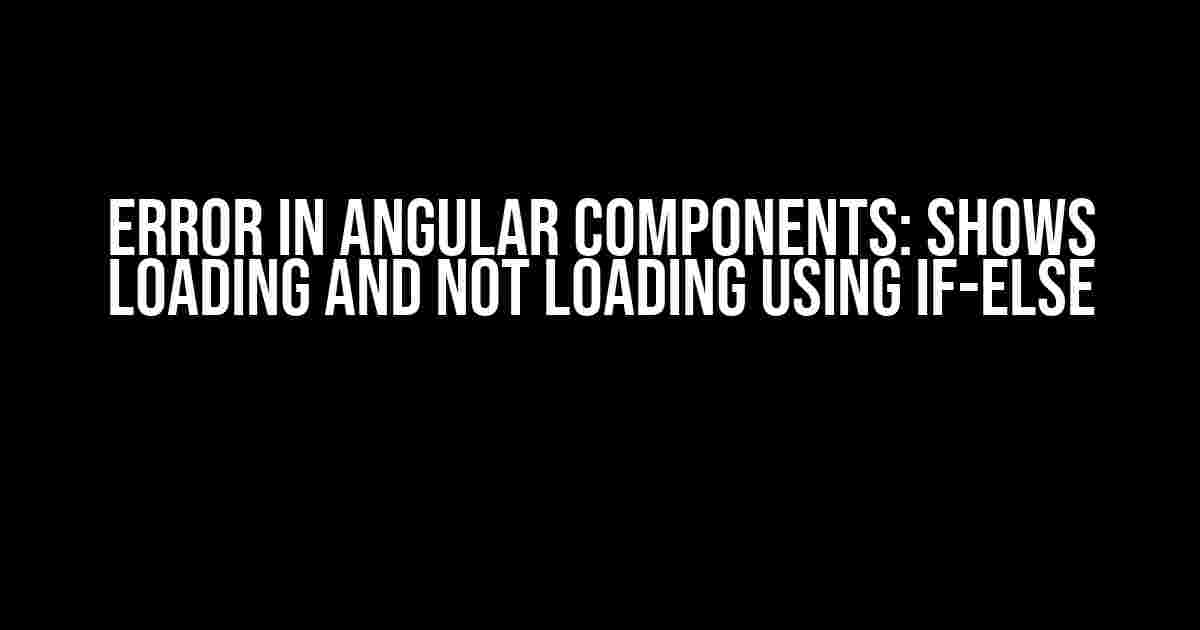Oh, the frustration of dealing with loading states in Angular components! You’ve built an amazing app, but suddenly, your loading indicators are misbehaving, and you’re left wondering what’s going on. Fear not, dear developer, for we’re about to dive into the world of error handling in Angular components, and explore how to use if-else statements to show loading and not loading states.
Understanding the Problem
Before we dive into the solution, let’s understand the problem. You’ve created an Angular component that fetches data from an API, and you want to show a loading indicator until the data is received. Sounds simple, right? But what happens when something goes wrong, and the data doesn’t arrive? Your loading indicator stays stuck, and your users are left wondering what’s happening.
This is where error handling comes in. You need to anticipate potential errors, and provide a fallback solution to handle them. In this case, we’ll explore how to use if-else statements to show a loading state when data is being fetched, and an error state when something goes wrong.
The Basic Setup
Let’s assume we have an Angular component that fetches data from an API using the HttpClient. We’ll create a basic component that displays a loading indicator while the data is being fetched.
import { Component, OnInit } from '@angular/core';
import { HttpClient } from '@angular/common/http';
@Component({
selector: 'app-data-component',
template: `
<div>
<img src="loading.gif" alt="Loading..." *ngIf="loading">
<ul>
<li>{{ item }}</li>
</ul>
</div>
`,
})
export class DataComponent implements OnInit {
loading = true;
data = [];
constructor(private http: HttpClient) {}
ngOnInit(): void {
this.http.get('https://api.example.com/data')
.subscribe((response: any) => {
this.data = response;
this.loading = false;
});
}
}
In this example, we’re using the `ngIf` directive to show a loading indicator while the `loading` property is `true`. Once the data is received, we set `loading` to `false`, and the loading indicator disappears.
The Problem with Error Handling
But what happens when the API request fails? In this case, the `loading` property remains `true`, and the loading indicator stays stuck. We need a way to handle errors and display an error state instead of the loading state.
One way to handle errors is by using the `catchError` operator from the `rxjs` library.
import { Component, OnInit } from '@angular/core';
import { HttpClient } from '@angular/common/http';
import { catchError } from 'rxjs/operators';
@Component({
selector: 'app-data-component',
template: `
<div>
<img src="loading.gif" alt="Loading..." *ngIf="loading">
<ul>
<li>{{ item }}</li>
</ul>
<p>Error: {{ error }}</p>
</div>
`,
})
export class DataComponent implements OnInit {
loading = true;
data = [];
error = '';
constructor(private http: HttpClient) {}
ngOnInit(): void {
this.http.get('https://api.example.com/data')
.pipe(
catchError((error: any) => {
this.error = error.message;
this.loading = false;
return [];
})
)
.subscribe((response: any) => {
this.data = response;
this.loading = false;
});
}
}
In this updated example, we’re using the `catchError` operator to catch any errors that occur during the API request. When an error occurs, we set the `error` property to the error message, and set `loading` to `false`. This way, the error state is displayed instead of the loading state.
Using if-else Statements for Error Handling
Now that we have a basic error handling mechanism in place, let’s explore how to use if-else statements to show a loading state when data is being fetched, and an error state when something goes wrong.
We can use the `ngIf` directive with an `else` clause to display different templates based on the `loading` and `error` properties.
<div>
<img src="loading.gif" alt="Loading..." *ngIf="loading; else errorTpl">
<ul>
<li>{{ item }}</li>
</ul>
</div>
<ng-template #errorTpl>
<p>Error: {{ error }}</p>
</ng-template>
In this example, we’re using the `ngIf` directive with an `else` clause to display the loading indicator while the `loading` property is `true`. When `loading` is `false`, the `errorTpl` template is displayed, which shows the error message.
We can take this approach further by using nested if-else statements to handle different error scenarios.
<div>
<img src="loading.gif" alt="Loading..." *ngIf="loading; else errorTpl">
<ul>
<li>{{ item }}</li>
</ul>
</div>
<ng-template #errorTpl>
<div *ngIf="error === 'Unauthorized'>
<p>You are not authorized to access this data.</p>
</div>
<div *ngIf="error === 'NotFound'>
<p>The requested data could not be found.</p>
</div>
<div *ngIf="error !== 'Unauthorized' && error !== 'NotFound'>
<p>An unknown error occurred: {{ error }}</p>
</div>
</ng-template>
In this example, we’re using nested if-else statements to handle different error scenarios. When the error is `Unauthorized`, we display a specific error message. When the error is `NotFound`, we display another error message. For all other errors, we display a generic error message with the error details.
Conclusion
In conclusion, handling errors in Angular components is crucial for providing a good user experience. By using if-else statements with the `ngIf` directive, we can show a loading state when data is being fetched, and an error state when something goes wrong. By catching errors using the `catchError` operator, we can handle errors in a centralized way and display error messages to the user.
Remember, error handling is not just about displaying error messages; it’s about providing a fallback solution to ensure your app remains functional even when something goes wrong.
Best Practices
Here are some best practices to keep in mind when handling errors in Angular components:
- Always handle errors in a centralized way using the `catchError` operator.
- Use if-else statements with the `ngIf` directive to show different templates based on the error state.
- Provide specific error messages for different error scenarios.
- Use error codes or error types to handle different error scenarios.
- Display error messages in a way that’s easy to understand for the user.
Frequently Asked Questions
Here are some frequently asked questions about error handling in Angular components:
| Question | Answer |
|---|---|
| How do I handle errors in Angular components? | Use the `catchError` operator to catch errors, and use if-else statements with the `ngIf` directive to display different templates based on the error state. |
| How do I display error messages to the user? | Use the `ngIf` directive to display error messages in a way that’s easy to understand for the user. |
| How do I handle different error scenarios? | Use error codes or error types to handle different error scenarios, and provide specific error messages for each scenario. |
I hope this article has helped you understand how to handle errors in Angular components using if-else statements. Remember to always prioritize error handling in your Angular app, and provide a good user experience even when something goes wrong
Frequently Asked Question
Get the answers to the most common questions about error handling in Angular components and learn how to use if-else statements to show or hide loading indicators.
Why does my Angular component show a loading indicator even when there’s no data to load?
This might be due to the fact that your if-else statement is not properly checking for the existence of data before showing the loading indicator. Make sure to use the Elvis operator ( ?. ) or the safe navigation operator to avoid null or undefined values. For example, `*ngIf=”data?.length > 0″` instead of `*ngIf=”data.length > 0″`. This way, the loading indicator will only show when there’s actual data to load.
How can I show a loading indicator while my Angular component is waiting for data from an API call?
You can use an if-else statement to show a loading indicator while waiting for data from an API call. For example, `*ngIf=”loading; else data”` where `loading` is a boolean flag set to true before making the API call and set to false once the data is received. The `else` clause will render the `data` template when the `loading` flag is false.
Why is my Angular component showing a loading indicator even after the data has been loaded?
This could be because you’re not properly resetting the loading flag after receiving the data. Make sure to set the `loading` flag to false in the `subscribe` method of your API call or in the `then` method of your promise. This will ensure that the loading indicator is hidden once the data is loaded.
How can I handle errors when making API calls in my Angular component and show a loading indicator only when necessary?
You can use a try-catch block to catch any errors that occur during the API call and set the `loading` flag to false in the catch block. Additionally, you can use an if-else statement to show an error message instead of the loading indicator when an error occurs. For example, `*ngIf=”loading; else dataError”` where `dataError` is a template that displays an error message.
What’s the best way to show a loading indicator in an Angular component while keeping it accessible and user-friendly?
To make your loading indicator accessible and user-friendly, use an HTML element with a role of “progressbar” and provide a descriptive text alternative. For example, `
`. This way, screen readers will announce the loading indicator to users with disabilities, and users will know what’s happening while waiting for the data to load.




